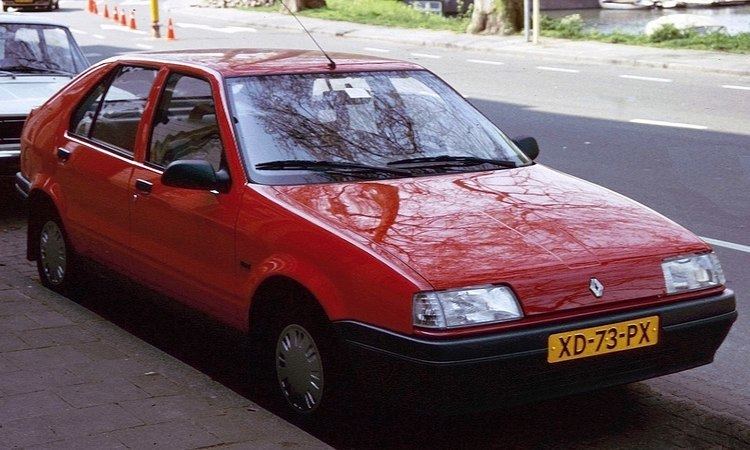Class Small family car (C) | ||
 | ||
The Renault 19 is a small family car that was produced by the French car manufacturer Renault between 1988 and 1996. In Turkey and in Argentina, production continued until 2000. The internal development code for the 19 was X53, with the five-door receiving the B53 chassis code, the three-door being the C53, the Chamade the L53, and the Cabriolet the D53.
Contents
Overview
The R19 was presented in June 1988, with sales in the domestic French market beginning in September 1988. It was the replacement for the 9 and 11, both of which were ageing and outdated by the late 1980s.
The R19 went on sale in right-hand drive form for the British market in February 1989.
The R19 was styled by Giorgetto Giugiaro, featuring Renault's new E-type (or "Energy") 1.4 L engine and F-type 1.7 L versions. Base models originally used the OHV C-type Cléon 1.2 and 1.4 L engines, depending on the market. While originally only available with an atmospheric diesel engine, a turbocharged version appeared in early 1992.
Intended to be Renault's last numeric-named car, the 19 ushered in a new naming policy, with the saloon versions of the 19 being known as the 19 Chamade to distinguish them from the hatchbacks. The saloon version was launched in 1989. In many markets the Chamade badge was dropped following the 1992 facelift, with some replacing it with the "Europa" tag. In 1991 a convertible bodystyle built by Karmann was first shown; few of these were built with the phase I design, as it was facelifted shortly afterwards.
Although the R19's exterior design (which was relatively conservative, like that of the Renault 9/11) received a muted response, it was praised for its interior comfort and handling.
For the fuel injected top versions a four-speed automatic transmission became available in the fall of 1990. Lesser versions still made do with four or five-speed manuals or a three-speed automatic.
A convertible version appeared in early 1992, only available with the two most powerful engine options.
In the summer of 1992, a revamped model was introduced with a substantially restyled front and rear, while LHD market versions received a new dashboard and interior — RHD models retained the original design. With the facelift, smaller "Energy"-series units gradually replaced the old pushrod items, and 1.8 litre engines appeared at the top of the lineup where they replaced the more powerful 1.7 units (the F3N).
The R19 was sold in most of Europe until 1996, and was produced for South American markets in Argentina until 2000. Turkish production lasted a little longer than in the rest of Europe, also until the year 2000. The R19's platform and running gear would continue to be used in its replacement, the first generation Renault Mégane, which lasted for seven years.
The Renault 19 was awarded the 1989 Car of the Year in Spain and Germany, 1990 Car of the Year in Ireland, and 1993 Car of the Year in Argentina.
16S hot hatch
The Renault 19 16S hot hatch (16V in some countries), added to the lineup in the autumn of 1990, was the only Renault 19 with 16-valve engine. It had a distinctive air inlet on the bonnet, a rear spoiler, 15 inch "Speedline" alloy wheels, side skirts, twin headlamps, Recaro bucket seats with optional leather trim, 4-in-1 exhaust manifold and ABS braking system with optional trip computer, aircon and electric sunroof. The "S" is for Soupapes, French for valves. It was praised for its excellent handling and rev-happy F7P engine which along with the advanced Renix ECU made it faster and more fuel efficient compared to most competitors. The braking system was uprated to include 259 mm (10.2 in) vented discs on the front and 237 mm (9.3 in) discs on the rear as well as an uprated lower suspension setup and front strut bar. Phase 1 editions benefited from unique front and rear bumpers with front indicators relocated into the bumpers to allow for the twin headlamps, while the Phase 2 retained the original bumpers found throughout the range but added colour-coded tops, rubber inserts, and a discreet lower splitter.
The very last models (1995-1996) were called Executive and came with leather interior as standard. A 16S version was also produced in Europe which was equipped as above - however, the earliest models did not sport the bonnet vent. The phase 2 models gear ratios were also revised to allow for the extra weight found in the safety equipment the later models carried. Renault claimed an acceleration from 0 to 100 km/h (62 mph) of 8.2 seconds. Each model boasted 137 PS (101 kW; 135 hp) in a catalysed form and a top speed of 215 km/h (134 mph). Phase I included a non-catalysed version with 140 PS (103 kW; 138 hp).
Engines
1 Only for South American model
